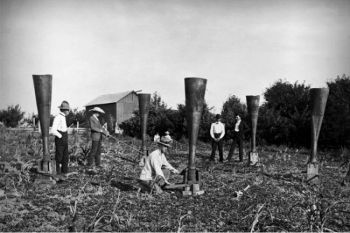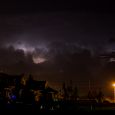The Gift of South Dakota
Subscriptions to South Dakota Magazine make great gifts!
Subscribe today — 1 year (6 issues) is just $29!
Making It Rain
Apr 22, 2014
Eastern South Dakota was in the throes of a drought in 1894. Farmers wanted nothing more than a few drops of rain to help their tiny crops grow and flourish. Then a man named Mr. Jewell from Iowa showed up in Sioux Falls and said he could provide exactly that.
Concerned citizens presented a petition with 40 signatures to the Minnehaha County Commission and asked them to appropriate $800 to have Jewell bring his gas tube and box trap and “mix up his chemicals and wet down Minnehaha County as it should be.” The commissioners refused, but the drought persisted and their constituents became ever more vocal. The sheriff and a few businessmen guaranteed Jewell $200 plus another $400 if he produced a fair amount of rain. Finally Jewell himself appeared before the commission on June 19.
“Jewell knew what he was talking about, and assured the commissioners that he had conducted 51 experiments, and had been successful 51 times,” according to the History of Minnehaha County. “He said, among other things, that he could produce rain under any circumstances, although it would not be so copious if high winds prevailed and the temperature was below 50 degrees, but with both of these obstacles in his way he could still milk the atmosphere. At Des Moines after the weather bureau had announced there were no prospects of rain and there was no moisture in the atmosphere within a circle of 100 miles of the city, he liberated the gas in the box car he was traveling about in, and it shot up into the ethereal canopy through his three little tin tubes and the parched earth was drenched with water.”
This convinced a majority of the commissioners, but Andrew Berdahl remained opposed. The Berdahls had come in a caravan of 11 covered wagons with other Norwegian families to Dakota Territory in 1873. Andrew Berdahl quickly became a respected member of the community around Garretson, but his moisture-starved neighbors railed against his stance. “When I came home from the rainmaking session to Garretson there was a farmer who wanted to beat me black and blue for voting against and writing something against the rainmaking,” Berdahl wrote in his memoir.
The commissioners agreed to pay Jewell $200 for chemicals and another $400 if he produced a half-inch of rain. Now the talk turned to logistics. One commissioner wanted the gases released in the geographical center of the county. Another man believed each commissioner’s district should receive the same amount of rain. Jewell assured them he could do just that.
After the meeting Jewell went to the local drugstore, bought $1.50 worth of chemicals, returned to his box car and “let loose to an unsuspecting, unprepared firmament all the gas he could produce from the materials he purchased.” The next day he announced through local newspapers that Sioux Falls would be deluged before 6 p.m. Thursday evening. But Thursday passed with no rain. On Friday, Jewell admitted “the great altitude of Sioux Falls made it difficult for him to inject his gas into the atmosphere and bring it down to the dew point.”
On Saturday a writer for the Sioux Falls Preset explained how ludicrous Jewell’s scheme had been. “He went at the problem from a scientific standpoint and demonstrated how impossible it would be, even by the use of trainloads of chemicals to condense the moisture in a single cubic mile of the atmosphere, to say nothing about causing a rainfall over an area of 816 square miles of territory.”
Jewell left Sioux Falls that very day, but not before selling the rights to use his invention in Hanson and McCook counties, bilking each local government out of $700. “Since then,” wrote a local reporter, “rainmakers are not on the schedule of quotations.”











Comments